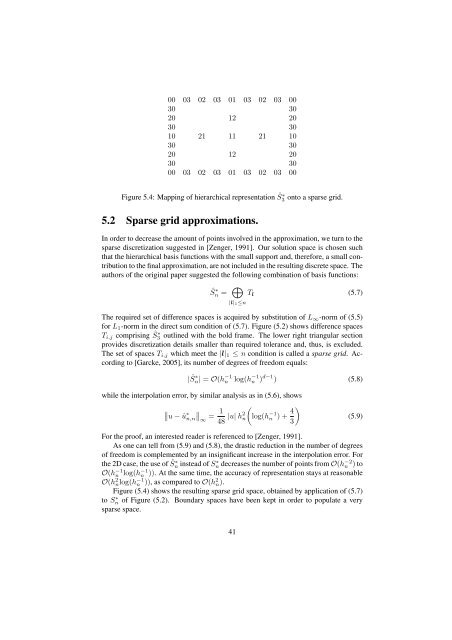sparse grid method in the libor market model. option valuation and the
sparse grid method in the libor market model. option valuation and the
sparse grid method in the libor market model. option valuation and the
Create successful ePaper yourself
Turn your PDF publications into a flip-book with our unique Google optimized e-Paper software.
00 03 02 03 01 03 02 03 00<br />
30 30<br />
20 12 20<br />
30 30<br />
10 21 11 21 10<br />
30 30<br />
20 12 20<br />
30 30<br />
00 03 02 03 01 03 02 03 00<br />
Figure 5.4: Mapp<strong>in</strong>g of hierarchical representation Ŝ∗ 3 onto a <strong>sparse</strong> <strong>grid</strong>.<br />
5.2 Sparse <strong>grid</strong> approximations.<br />
In order to decrease <strong>the</strong> amount of po<strong>in</strong>ts <strong>in</strong>volved <strong>in</strong> <strong>the</strong> approximation, we turn to <strong>the</strong><br />
<strong>sparse</strong> discretization suggested <strong>in</strong> [Zenger, 1991]. Our solution space is chosen such<br />
that <strong>the</strong> hierarchical basis functions with <strong>the</strong> small support <strong>and</strong>, <strong>the</strong>refore, a small contribution<br />
to <strong>the</strong> f<strong>in</strong>al approximation, are not <strong>in</strong>cluded <strong>in</strong> <strong>the</strong> result<strong>in</strong>g discrete space. The<br />
authors of <strong>the</strong> orig<strong>in</strong>al paper suggested <strong>the</strong> follow<strong>in</strong>g comb<strong>in</strong>ation of basis functions:<br />
Ŝn ∗ = ⊕<br />
T l (5.7)<br />
|l| 1≤n<br />
The required set of difference spaces is acquired by substitution of L ∞ -norm of (5.5)<br />
for L 1 -norm <strong>in</strong> <strong>the</strong> direct sum condition of (5.7). Figure (5.2) shows difference spaces<br />
T i,j compris<strong>in</strong>g Ŝ∗ 3 outl<strong>in</strong>ed with <strong>the</strong> bold frame. The lower right triangular section<br />
provides discretization details smaller than required tolerance <strong>and</strong>, thus, is excluded.<br />
The set of spaces T i,j which meet <strong>the</strong> |l| 1 ≤ n condition is called a <strong>sparse</strong> <strong>grid</strong>. Accord<strong>in</strong>g<br />
to [Garcke, 2005], its number of degrees of freedom equals:<br />
|Ŝ∗ n| = O(h −1<br />
n<br />
log(h −1<br />
n ) d−1 ) (5.8)<br />
while <strong>the</strong> <strong>in</strong>terpolation error, by similar analysis as <strong>in</strong> (5.6), shows<br />
∥<br />
∥u − û ∗ ∥<br />
n,n ∞<br />
= 1 (<br />
48 |u| h2 n log(h −1<br />
n ) + 4 )<br />
3<br />
(5.9)<br />
For <strong>the</strong> proof, an <strong>in</strong>terested reader is referenced to [Zenger, 1991].<br />
As one can tell from (5.9) <strong>and</strong> (5.8), <strong>the</strong> drastic reduction <strong>in</strong> <strong>the</strong> number of degrees<br />
of freedom is complemented by an <strong>in</strong>significant <strong>in</strong>crease <strong>in</strong> <strong>the</strong> <strong>in</strong>terpolation error. For<br />
<strong>the</strong> 2D case, <strong>the</strong> use of Ŝ∗ n <strong>in</strong>stead of Sn ∗ decreases <strong>the</strong> number of po<strong>in</strong>ts from O(h −2<br />
n ) to<br />
O(h −1<br />
n log(h −1<br />
n )). At <strong>the</strong> same time, <strong>the</strong> accuracy of representation stays at reasonable<br />
O(h 2 nlog(h −1<br />
n )), as compared to O(h 2 n).<br />
Figure (5.4) shows <strong>the</strong> result<strong>in</strong>g <strong>sparse</strong> <strong>grid</strong> space, obta<strong>in</strong>ed by application of (5.7)<br />
to Sn ∗ of Figure (5.2). Boundary spaces have been kept <strong>in</strong> order to populate a very<br />
<strong>sparse</strong> space.<br />
41
















